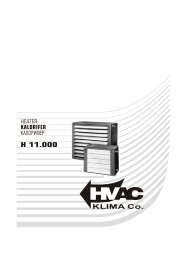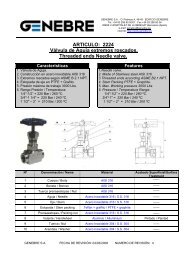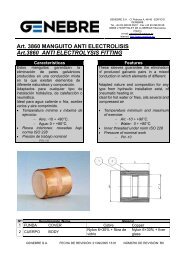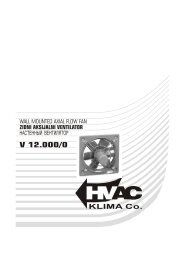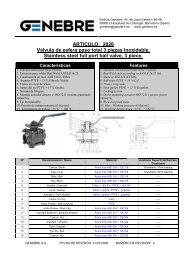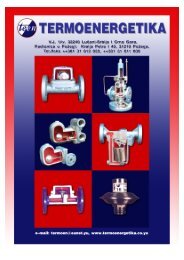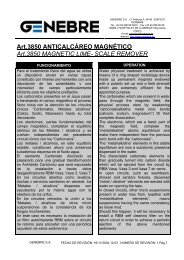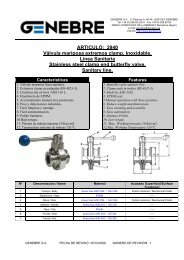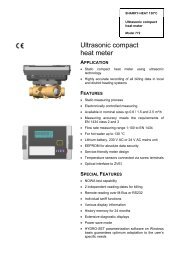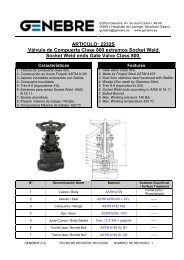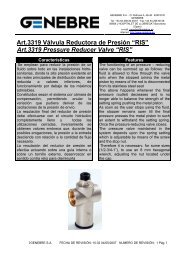Art.: 71028 Válvula Monotubo Termostatizable Thermostatic ... - TDM
Art.: 71028 Válvula Monotubo Termostatizable Thermostatic ... - TDM
Art.: 71028 Válvula Monotubo Termostatizable Thermostatic ... - TDM
Create successful ePaper yourself
Turn your PDF publications into a flip-book with our unique Google optimized e-Paper software.
GENEBRE S.A. · Avda. Joan Carles I, 46-48 · EDIFICIO GENEBRE<br />
Tel. +34 93 298 80 00/01 · Fax +34 93 298 80 06<br />
08908 L’HOSPITALET DE LLOBREGAT Barcelona (Spain)<br />
e-mail: genebre@genebre.es<br />
internet: http://www.genebre.es<br />
Función<br />
La instalación denominada monotubo consta de<br />
una sola tubería, con los radiadores conectados en<br />
serie. El retorno del primer radiador es la ida del<br />
segundo, y así sucesivamente. Es necesario<br />
montar válvulas monotubo de 4 vías destinadas a<br />
dosificar el caudal que entra en cada radiador.<br />
Se considera un sistema más económico por<br />
precisar una instalación más sencilla, con menos<br />
tubería, sin embargo el cálculo de la superficie<br />
radiante de cada radiador es más riguroso y<br />
complicado que en el sistema tradicional bitubo.<br />
Cuando la válvula está en posición totalmente<br />
abierta, se deriva el 100% del caudal de agua. En<br />
posición totalmente cerrada, impide el paso del<br />
agua al radiador, recirculando el 100% del caudal<br />
por el circuito, con ello se permite actuar en el<br />
radiador sin necesidad de vaciar el circuito.<br />
Las válvulas son reversibles, la dirección del<br />
flujo en el interior de la válvula es indiferente.<br />
Con ello se evitan problemas durante su<br />
instalación.<br />
La válvula incorpora una sonda que permite dirigir<br />
en el radiador el flujo de ida y de retorno. Para<br />
conseguir un buen rendimiento, es recomendable<br />
colocar la sonda con una longitud cercana al 2/3 de<br />
la longitud del radiador.<br />
La válvula incorpora un detentor para limitar la<br />
apertura máxima de la misma y realizar el<br />
equilibrado de la instalación. Con el detentor y el<br />
accionamiento totalmente cerrado, el radiador<br />
queda aislado del circuito, lo que permite realizar<br />
cualquier operación en el mismo.<br />
La válvula termostatizable permite el montaje de<br />
mandos termostáticos o electrotérmicos para<br />
regular la temperatura ambiente de modo<br />
automático.<br />
Instalación<br />
La válvula se puede montar con las conexiones<br />
hacia la pared o hacia el suelo, pero siempre con la<br />
sonda en horizontal. La conexión de los tubos no<br />
tiene un sentido de entrada o salida obligatorio,<br />
pero se aconseja hacer la entrada en la conexión<br />
más alejada del radiador para obtener un mayor<br />
rendimiento de la instalación. Para aislar el emisor<br />
de calor hay que cerrar el grupo termostatizable y<br />
el detentor.<br />
El procedimiento de instalación es el siguiente:<br />
• Instalar la válvula en los tubos de ida y retorno<br />
del fluido.<br />
• Insertar y fijar la sonda en el radiador.<br />
• Roscar la unión del portasonda a la válvula.<br />
Durante la instalación, tener cuidado de no dañar la<br />
sonda.<br />
Function<br />
At the one-pipe radiator systems, radiators are<br />
connected in series. Return of the first radiator is the<br />
inlet of the second, and so on. It’s necessary install 4<br />
ways one-pipe valves to dose the flow in each radiator.<br />
It’s considered a more economical system to be<br />
specified easier installation, less pipe; however the<br />
calculation of the radiating surface of each radiator is<br />
more rigorous and complicated than the traditional twopipe<br />
radiator systems.<br />
When the valve is in fully open position, is derived<br />
100% of the water flow. In the fully closed position,<br />
block the water flow to the radiator, 100% recirculating<br />
flow in the circuit, this allows the radiator to act without<br />
emptying the installation.<br />
The valves are reversible; the direction of flow<br />
inside the valve is indifferent. This avoids<br />
problems during installation.<br />
The valve incorporates a probe that allows the radiator<br />
to direct the flow outward and return. To achieve a<br />
good efficiency, it is advisable to place the pipe with a<br />
length close to 2/3 of the length of the radiator.<br />
The valve incorporates a lockshield valve to limit the<br />
maximum opening and set the balancing of the<br />
installation. With the lockshield valve and the steering<br />
wheel fully closed, the radiator is isolated from the<br />
circuit, which allows any operation on it.<br />
<strong>Thermostatic</strong> convertible allow the mounting of<br />
thermostatic or electro-thermal controls to regulate<br />
ambient temperature automatically.<br />
Installation<br />
The valve can be installed with the connections facing<br />
the wall or pointing downwards but always with the<br />
probe horizontal. The pipe connections are<br />
interchangeable although is advisable connect the inlet<br />
with the connection farthest from the radiator to get a<br />
higher efficiency of the installation. To isolate the<br />
radiator, shut off the control knob and the lockshield<br />
valve.<br />
The installation procedure follows:<br />
• Install the valve on both the flow and return pipe.<br />
• Insert and screw the probe inside the radiator.<br />
• Screw the probe holder’s union to the valve body.<br />
During installation it is necessary to avoid any damage<br />
to the probe itself.<br />
GENEBRE S.A. FECHA DE REVISIÓN: 20/05/2010 NUMERO DE REVISION: R0



